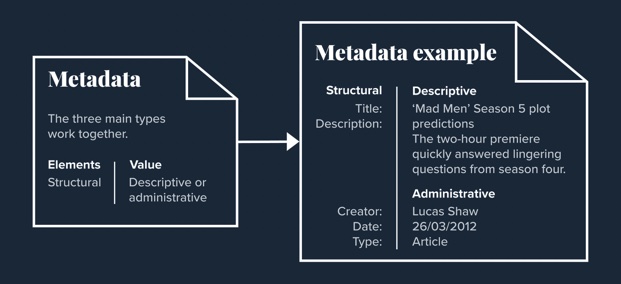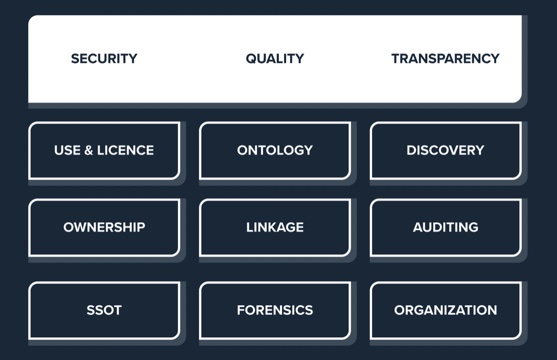
How does Spotify win against a competitor like Apple? They use data better. Using machine learning and AI, Spotify creates value for their users by providing a more personalized experience.
Let’s take a quick look at the layers of aggregate information that are used to enhance their platform:
– Spotify uses natural language processing (NLP) to scan discussion forums about the music you’re listening to, then matches your preferences to other music being discussed similarly. This provides additional dimensionality to their classification system.
– The composition of the music is analyzed for tone, volume, major or minor key, and several other factors in order to recommend similar songs and artists.
– Finally, Spotify measures behavior when listening to music, tracking repeat plays or skips. These behavioral metrics help in establishing preferences, and, therefore improve the recommendations to the user.
The core data here are the basic descriptors of songs, such as the title, artist, and duration. Choosing a song to listen to sets the baseline. Everything else can be seen as metadata: additional information about how you listen to it, how the song is composed, and what other music it sounds like.
Metadata, here, is the driving force of Spotify’s algorithm, and it’s collected and applied constantly to provide you with intelligent recommendations to keep you listening.
What is Metadata?
In simple terms, within the technology industry, “meta” refers to an underlying definition or description. More directly, metadata provides context about the data, more than what you see in the rows and columns.
That definition is quite broad, but that’s mostly because it can be used for almost any purpose. It can tell you what each column header means in detail, who uploaded the data and when, the column and row count for the whole dataset, the original data source, or even warehousing and residency requirements.
Breaking Down Metadata
There are 3 main types of metadata that work together: administrative, descriptive, and structural. Each serves a different purpose in explaining the corresponding data.
Structural metadata – provides insight regarding how data elements are organized. This facilitates quick and easy navigation, like a table of contents or page numbers. Structural metadata allows similar data to be grouped together, documenting relationships among different data.
Administrative metadata – offers technical information about the data. It covers aspects such as the origin of the data, type of data, and access or usage licenses.
Descriptive metadata – adds information about the owner, when the data was created/published, and what the data includes. The essential purpose is to ease identification and offer a snapshot of the data it describes.
A combination of these types of metadata allows organizations to navigate through vast amounts of data efficiently, making it easy to find what you need, when you need it.
Why is Metadata Important?
51% of analytics consumers have difficulty locating and accessing data content. With increasing amounts of data, it is important for organizations to understand the data they have, where it is, and how to use it.
Metadata’s utility does not begin and end with describing data. Metadata can enable easier data discovery and can help increase understanding of a dataset. Take a library book, for example. If the text is the primary data, the book jacket may have a brief summary of and comments from others about the book. Importantly, the library may also append data that gives the book a category, genre, and unique identifier for easier organization and retrieval.
Metadata can also assist in compliance with regulatory requirements by ensuring that your organization tracks usage, sharing, and license permissions at the dataset level. By appending metadata that makes it clear how the data can be used, for what purpose, and who it can or can’t be shared with, you’re able to build security and compliance into the data itself.
Metadata management through a data catalog solution
By managing your metadata, you’re effectively creating an encyclopedia of your data assets. Metadata management is a subset of data management, which itself falls into the category of data governance.
The primary reasons to focus on metadata management, then, are the same reasons for implementing data governance strategies: improving data security, data quality, and overall transparency.
Improving data security:
- Ties usage restrictions and data licensing directly to data
- Includes data ownership
- Consolidates and codifies information associated with a dataset so that it can’t be lost
Improving data quality:
- Designs and implements ontology
- Makes data linkage easier
- Gives insight into change to the over time
Improving transparency:
- Increases discoverability
- Creates records of usage, access, and updates
- Shares information without revealing sensitive data
Instead of treating metadata as additional attributes, files, and pieces of information that exist outside the data, metadata management is about linking this rich information to the dataset itself in a way that’s easy to access, enforce, and manage.
Metadata management falls under the branch of data governance, one of the most crucial parts of an effective data strategy. We know that every organization has unique needs, and a good metadata solution should be strong and enforceable, but flexible enough to manage data in a way that’s tailored to each company.


